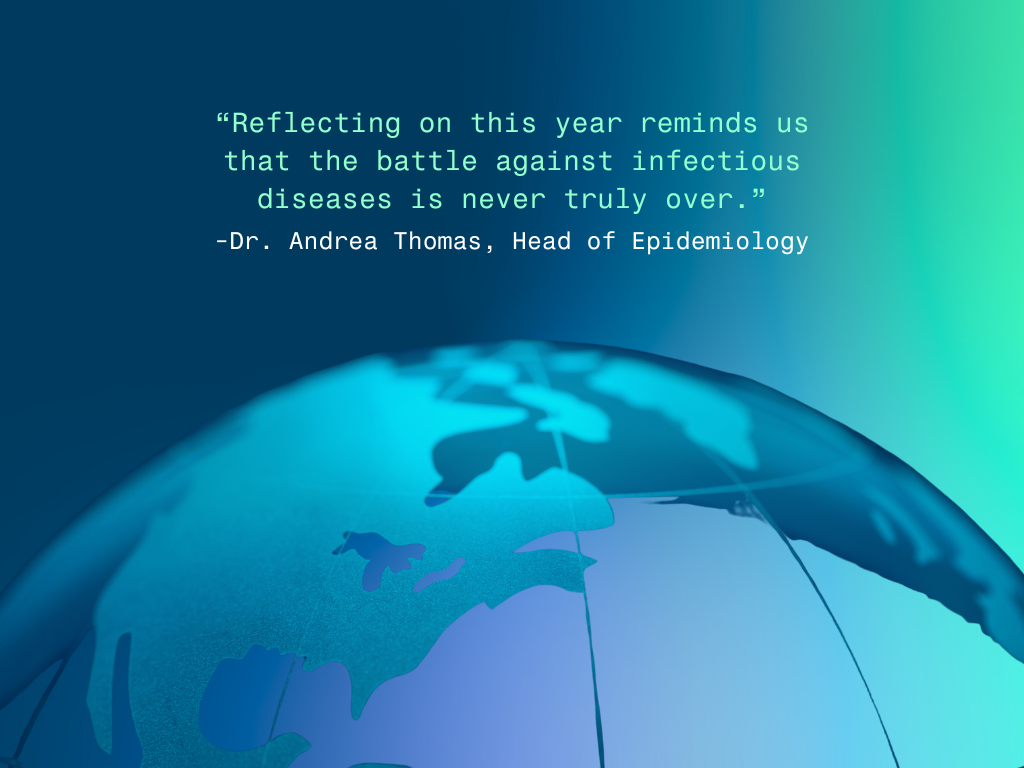The Mother Continent is confronting multiple disease outbreaks and humanitarian crises, underscoring the importance of coordinated global health efforts
Last week, the Africa Centres for Disease Control and Prevention (CDC) and the World Health Organization (WHO) reported that Africa is experiencing at least 57 concurrent disease outbreaks. From Marburg Virus Disease (MVD) in Tanzania to Sudan Virus Disease (SVD, one of the five Ebola subtypes) in Uganda and mpox in several nations across the continent, high-consequence diseases are spreading rapidly and threatening the health and security of millions.
They also reported that effective response is being hindered by 32 ongoing humanitarian crises, including climate- and conflict-related events. At the end of January, violence erupted in Goma, the capital city of the Democratic Republic of the Congo (DRC), where nearly 3,000 people were confirmed killed. Disease detection, treatment, and vaccination programs were disrupted as people fled and facilities were damaged. With more than one million people displaced, the risk of further mpox transmission has increased, as has the threat of additional infectious diseases, such as cholera and measles.
“Ongoing conflict across Africa is a public health problem to combat on top of all of the diseases circulating,” says Dr. Hernán Acosta, Medical Science Liaison with BlueDot. This edition of Outbreak Insider explores the regional public health concerns in Africa, challenges with response, and the importance of coordinated global efforts to prevent continued regional — and international — spread.
A Synopsis of Infectious Disease Spread in Africa
In their joint press briefing on February 6, Africa CDC and the WHO reported that several countries are tackling disparate pathogens, including mpox in 16 member states, MVD in Tanzania, SVD in Uganda, cholera in 14 countries, and dengue in 7 countries.
Map of ongoing outbreaks and public health emergencies in Africa

Note: This map does not include ongoing complex humanitarian crises in the DRC, Ethiopia, Burundi, Burkina Faso, CR, Chad, Mali, Mozambique, Niger, and Nigeria.
Source: WHO-Afro-Weekly-Bulletin (Jan 27-Feb 2), created with Datawrapper.
On average, Africa experiences 2-3 new public health events weekly, amounting to roughly 100 to 150 events every year. Over time, Africa has strengthened surveillance systems, allowing for more testing, detection, and treatment of infectious diseases. Even so, the number of disease outbreaks totaled 242 in 2024, well above the continent’s expected annual tally.
Amid the sheer volume of outbreaks, Africa is confronting familiar infectious diseases while simultaneously working to contain high-consequence outbreaks such as MVD, which has an average case fatality rate of 50%. Despite improved public health capabilities, these infectious diseases require resource-intensive responses.
The first few weeks of 2025 have seen significant mpox outbreaks in 12 countries across Africa, including the DRC, Burundi, and Uganda. Between December 29 and January 25, 13,531 cases of mpox were notified and 107 deaths were reported. More than 20,000 cases have been confirmed in 21 countries across the continent in the last 12 months. As reported in a previous edition of Outbreak Insider, the DRC is the epicenter of the outbreak, although neighboring Burundi and Uganda are reporting 100-200 new cases weekly. Together, these three countries account for 97.5% of new cases. Cross-border transmission is an ongoing concern.
Map of mpox in Africa

Source: Created by BlueDot using WHO Mpox data
Declared a Public Health Emergency of International Concern by the WHO on August 14, 2024, mpox has continued to spread across the continent — and internationally. BlueDot has detected travel-related cases of mpox clade Ib in at least 12 countries in regions around the world, including Europe, North America, and Asia. To date, confirmed clade Ib cases have been reported in Sweden, Thailand, India, the US, Canada, Pakistan, the United Kingdom, Germany, Belgium, China, France, and more recently in Ireland. For instance, four imported cases linked to travel to Uganda have been detected in the UK so far this year, bringing the total imported clade Ib cases in the country to nine. And though mpox remains low risk in the UK, imported cases highlight the importance of global vigilance and timely response to prevent further transmission.
3 Top Takeaways
- Outbreaks overwhelm Africa. The continent is currently battling at least 57 disease outbreaks, including mpox, MVD, and EVD. These high-consequence diseases are circulating amid several more common infectious diseases, such as malaria and dengue — a dangerous combination that threatens public health.
- Humanitarian crises are impeding disease prevention. Public health efforts have been disrupted while Africa grapples with 32 ongoing humanitarian crises. Not only do these events limit the surveillance and treatment capacities of circulating infectious diseases, but they also create additional challenges, facilitating the emergence and spread of other pathogens.
- Regional health crises are a global health concern. Pathogens are borderless. In an increasingly connected world, coordinated efforts help prevent the spread of infectious diseases around the world.
Severe hemorrhagic fevers are also traversing the continent. Since the end of January, two confirmed and an additional eight probable cases of MVD have been reported in Tanzania, with a case fatality rate of 100%. This is the second recorded MVD outbreak in the country and follows on the heels of the recent outbreak in Rwanda, which resulted in 15 deaths.
On January 30, the Ministry of Health of Uganda declared an outbreak of SVD after a nurse contracted the virus and died. As of February 4, there have been nine confirmed cases and one death.
Uganda’s last outbreak, in 2022, resulted in 142 confirmed cases and 55 deaths. Health officials are closely monitoring the current Ebola outbreak — the country’s eighth since 2000 — for additional cases. Over 1.3 million people are affected, and the International Federation of Red Cross and Red Crescent Societies has initiated a Disaster Relief Emergency Fund operation.
Outbreaks of hemorrhagic fevers have increased in frequency over time. For infectious diseases with high fatality rates and no approved vaccines such as MVD and Ebola, prevention relies heavily on reducing transmission. Yet the full chains of transmission for both outbreaks remain poorly understood, making containment a greater challenge and posing an increased risk to vulnerable populations, including healthcare workers.
Timeline of Ebola and MVD Outbreaks in Africa

Source: BlueDot, 11-Feb-2025. From Multiple Official Sources.
Blue dots represent Marburg outbreaks; purple signal Ebola virus outbreaks, and orange represents years in which both Ebola and Marburg outbreaks were confirmed. The red dot represents an Ebola PHEIC declaration.
To control the ongoing outbreaks, national and international health agencies have teamed up. The Ugandan Ministry of Health, Africa CDC, and the WHO launched an mpox vaccination campaign earlier this month to stop disease spread. For MVD and Ebola, public health measures, including surveillance, treatment centers, and risk communication have been bolstered. The WHO shipped 1.4 tons of emergency medical supplies to mitigate transmission of MVD. An Ebola vaccine trial was launched on February 3, which will deploy over 2,000 doses of a candidate vaccine targeting high-risk individuals. The situation requires all-hands-on-deck to navigate the continent’s concurrent challenges.
Humanitarian crises contribute to health crises
Complicating the public health responses to these outbreaks are humanitarian crises ranging from political violence to natural disasters. The DRC, Northern Ethiopia, the Sahel and South Sudan, and Cabo Delgado are experiencing ongoing conflicts, contributing to record levels of forced displacement. Meanwhile, Mozambique, Madagascar, and Mayotte are recovering from Cyclones Chido and Dikeledi, which recently swept through.
Humanitarian events result in devastating health effects, from acute injuries and loss of life to disrupted healthcare services and access to food, water, and sanitation. These events also provide a breeding ground for infectious disease emergence and transmission. Cholera, tuberculosis, and Ebola are just a few illnesses that have been detected in previous conflicts in the DRC, South Sudan, Nigeria, Yemen, and Syria. Key drivers of health emergencies during conflict situations include population displacement, disrupted disease control programs, damaged infrastructure and health systems, and lack of access to healthcare services and safe water, food, and medication.
The DRC’s current situation is a case in point. Amid political violence, approximately 700,000 internally displaced people residing in a camp have fled, as have mpox patients in treatment centers, increasing the potential for the disease to spread and disrupting needed care. The mpox vaccination program was halted but has partly resumed following the declaration of a unilateral ceasefire. With no running water and no electricity in parts of the capital, plus a partly-burglarized World Food Program warehouse, the situation is a dire public health crisis.
A crucial facet of preparedness and response strategies during humanitarian crises is political commitment and collaboration between governments and international organizations. These events are costly and require international aid during and often long after peace has been achieved, or a natural disaster has occurred. So far, the WHO has spent $600,000 USD to support the immediate needs of the current humanitarian event in the DRC; it estimates that up to $50 million USD will be needed, underscoring the critical importance of donor support.
Even when humanitarian events may not cross borders, the resulting health crises often do. Infectious disease outbreaks and challenges in containment measures mean illnesses can spread far and wide very rapidly. “We are all connected to the events happening in Africa,” says Andrea Thomas, PhD, BlueDot’s head of epidemiology. “No one is safe until everyone is safe.”
On our radar
- Yellow fever in Brazil: On February 4, the Pan American Health Organization issued an epidemiological alert for yellow fever following an increase in cases in numerous South American countries, notably Brazil. As of February 6, Brazil was reporting seven cases of yellow fever, four of them fatal, all in the state of São Paulo.
- Guillain-Barré Syndrome (GBS) in India: At least 180 cases and seven deaths of GBS, a rare neurological disorder, have been reported in the state of Maharashtra. Often linked to Campylobacter jejuni bacteria, experts are working to identify the source, which may be tied to contaminated water. The WHO has joined local health authorities to help identify the source, detect cases, and treat patients.
- Avian influenza in the US: Nevada reported its first human case of H5N1 amid reports that a new variant, D1.1, was confirmed in dairy cattle. Detected in six herds across the state, this strain had only been detected in birds and people, indicating that the spread likely represents a new spillover event — not just cow-to-cow transmission. This is a concern as it indicates an ongoing risk from wild birds to dairy farms, while the outbreak continues to impact the dairy and poultry industry across the nation.
Leveraging technology and subject matter expertise, BlueDot tracks infectious disease outbreaks around the globe. To keep updated, sign up here to receive every edition of BlueDot Outbreak Insider.









